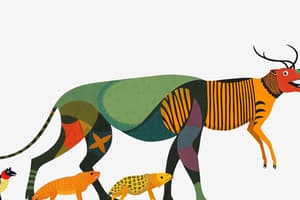Podcast
Questions and Answers
What is one characteristic that sets living things apart from non-living things?
What is one characteristic that sets living things apart from non-living things?
- Size
- Texture
- Reproduction (correct)
- Color
Which of the following is an example of a carnivore based on the text?
Which of the following is an example of a carnivore based on the text?
- Wolves (correct)
- Rabbits
- Cows
- Caterpillars
What is the term used for organisms that regulate their internal conditions like temperature and water balance?
What is the term used for organisms that regulate their internal conditions like temperature and water balance?
- Heterotrophs
- Homeostasis (correct)
- Herbivores
- Omnivores
Which mode of nutrition involves organisms acquiring nutrients by consuming other organisms?
Which mode of nutrition involves organisms acquiring nutrients by consuming other organisms?
What do omnivores feed on according to the text?
What do omnivores feed on according to the text?
What is the primary characteristic of autotrophs?
What is the primary characteristic of autotrophs?
Which organism is an example of a chemotroph?
Which organism is an example of a chemotroph?
What do primary consumers primarily feed on?
What do primary consumers primarily feed on?
Which of the following is a role of decomposers in an ecosystem?
Which of the following is a role of decomposers in an ecosystem?
What makes secondary consumers different from primary consumers?
What makes secondary consumers different from primary consumers?
Flashcards are hidden until you start studying
Study Notes
Overview of Living and Non-Living Things
In our daily lives, we often come across various things which can be classified either as living or non-living. Understanding the differences between these two categories is essential for understanding the world around us. This article will focus on the classification of living things.
What Are Living Things?
Living things, also known as organisms, have several characteristics that set them apart from non-living things:
- They grow and develop over time.
- They respond to their environment.
- They maintain homeostasis, meaning they regulate their internal conditions like temperature and water balance.
- They reproduce, creating more organisms that are similar to themselves.
- They metabolize, using energy to break down food molecules into simpler compounds for growth.
How Are Organisms Classified?
Organisms can be broadly categorized based on how they obtain food, which is called the mode of nutrition. There are four primary modes of nutrition:
-
Heterotrophs: These organisms acquire nutrients by consuming other organisms. Heterotrophs can further be divided into two groups:
- Carnivores: These organisms feed on other animals. Examples include lions, wolves, and sharks.
- Herbivores: These organisms feed on plants. Examples include cows, rabbits, and caterpillars.
- Omnivores: These organisms feed on both plants and animals. Examples include humans, bears, and pigs.
-
Autotrophs: These organisms produce their own food through photosynthesis or chemosynthesis. They can be further classified into:
- Phototrophs: These organisms use sunlight to produce food. Examples include plants, algae, and some bacteria.
- Chemotrophs: These organisms obtain energy by breaking down chemicals. Examples include nitrifying bacteria and sulfur bacteria.
-
Producers: These organisms produce food through photosynthesis or chemosynthesis. Producers are typically autotrophs.
-
Consumers: These organisms feed on other organisms. Consumers can be further classified into:
- Primary consumers: These organisms feed on producers. Examples include rabbits, grasshoppers, and some species of fish.
- Secondary consumers: These organisms feed on primary consumers. Examples include foxes, hawks, and some species of fish.
- Tertiary consumers: These organisms feed on secondary consumers. Examples include sharks, eagles, and some species of fish.
- Decomposers: These organisms feed on dead organisms and break down complex organic compounds into simpler ones.
Conclusion
Understanding the classification of living things is crucial for understanding the complex relationships between organisms in various ecosystems. By recognizing the different modes of nutrition and the roles that organisms play within their food chains, we can appreciate the intricate balance that exists within our natural world.
Studying That Suits You
Use AI to generate personalized quizzes and flashcards to suit your learning preferences.




